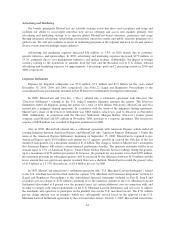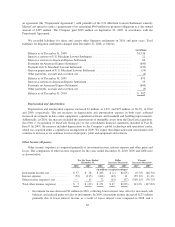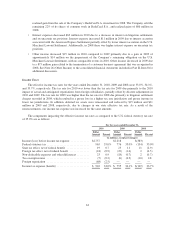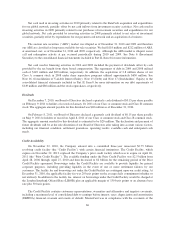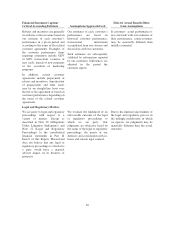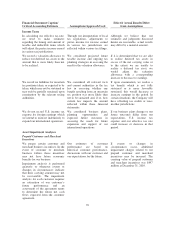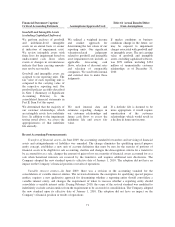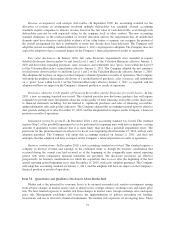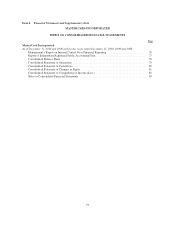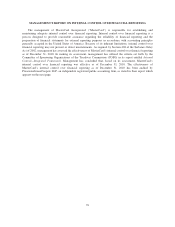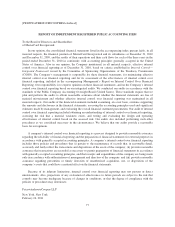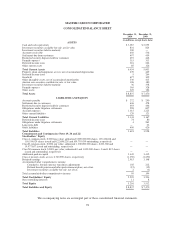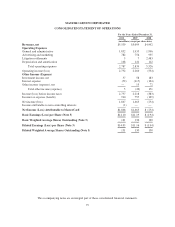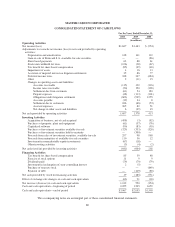MasterCard 2010 Annual Report Download - page 81
Download and view the complete annual report
Please find page 81 of the 2010 MasterCard annual report below. You can navigate through the pages in the report by either clicking on the pages listed below, or by using the keyword search tool below to find specific information within the annual report.
Financial Statement Caption/
Critical Accounting Estimate Assumptions/Approach Used
Effect if Actual Results Differ
from Assumptions
Goodwill and Intangible Assets
(excluding Capitalized Software)
We perform analyses of goodwill
and indefinite-lived intangible
assets on an annual basis or sooner
if indicators of impairment exist.
We review intangible assets with
finite lives for impairment based on
undiscounted cash flows when
events or changes in circumstances
indicate that their carrying amounts
may not be recoverable.
Goodwill and intangible assets are
assigned to our reporting units. The
fair value of each reporting unit is
compared to the carrying value of
the respective reporting unit. Our
goodwill policies are fully described
in Note 1 (Summary of Significant
Accounting Policies) to the
consolidated financial statements in
Part II, Item 8 of this report.
We utilized a weighted income
and market approach for
determining the fair values of our
reporting units. Our significant
valuation-related judgments
related to goodwill and intangible
asset impairment tests include, as
applicable, forecasting cash
flows, selection of discount rates
and selection of comparable
companies. We used both internal
and external data to make these
judgments.
If market conditions or business
conditions change in the future, we
may be exposed to impairment
charges associated with goodwill and/
or intangible assets. The net carrying
value of goodwill and intangible
assets, excluding capitalized software,
was $971 million, including $194
million of unamortizable customer
relationships, as of December 31,
2010.
We determined that the majority of
our customer relationships, which
are intangible assets, have indefinite
lives. In addition to the impairment
testing noted above, we assess the
appropriateness of that indefinite
life annually.
We used internal data and
estimates regarding changes in
our customer relationships and
future cash flows to assess the
indefinite life and assess fair
value.
If a definite life is deemed to be
more appropriate, it would require
amortization of the customer
relationships which would result in
a decline in future net income.
Recent Accounting Pronouncements
Transfers of financial assets—In June 2009, the accounting standard for transfers and servicing of financial
assets and extinguishments of liabilities was amended. The change eliminates the qualifying special purpose
entity concept, establishes a new unit of account definition that must be met for the transfer of portions of
financial assets to be eligible for sale accounting, clarifies and changes the derecognition criteria for a transfer to
be accounted for as a sale, changes the amount of gain or loss on a transfer of financial assets accounted for as a
sale when beneficial interests are received by the transferor, and requires additional new disclosures. The
Company adopted the new standard upon its effective date of January 1, 2010. The adoption did not have an
impact on the Company’s financial position or results of operations.
Variable interest entities—In June 2009, there was a revision to the accounting standard for the
consolidation of variable interest entities. The revision eliminates the exemption for qualifying special purpose
entities, requires a new qualitative approach for determining whether a reporting entity should consolidate a
variable interest entity, and changes the requirement of when to reassess whether a reporting entity should
consolidate a variable interest entity. During February 2010, the scope of the revised standard was modified to
indefinitely exclude certain entities from the requirement to be assessed for consolidation. The Company adopted
the new standard upon its effective date of January 1, 2010. The adoption did not have an impact on the
Company’s financial position or results of operations.
71


